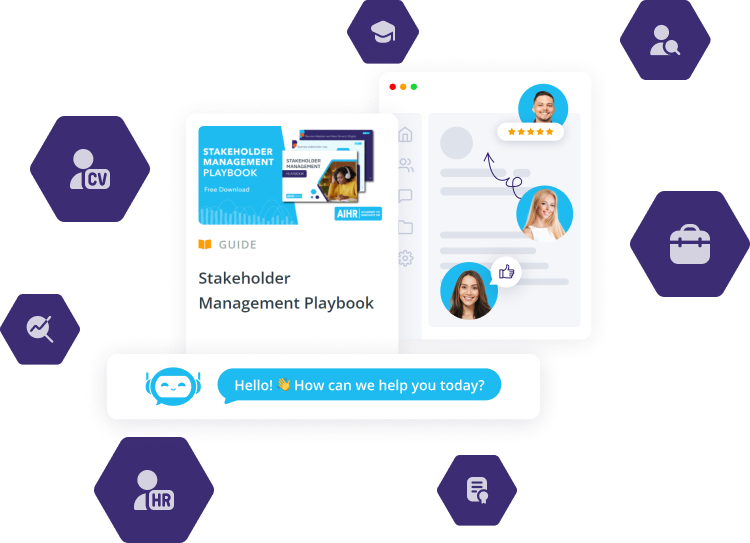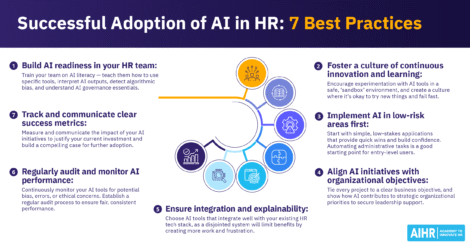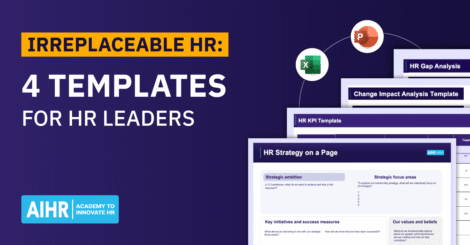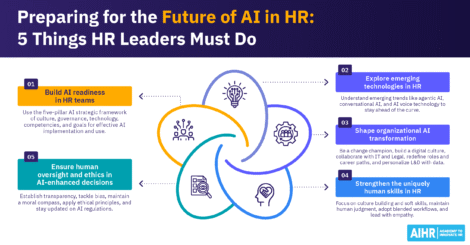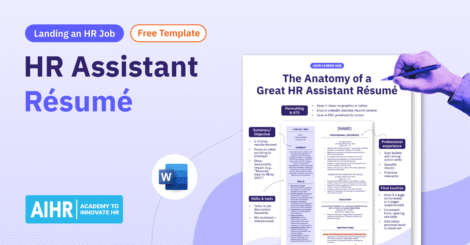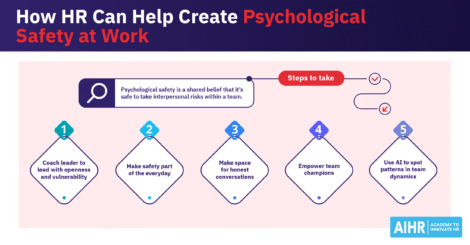Writing an effective HR audit report is not simply an exercise in compiling data and listing your findings. Astute HR leaders understand that the value of these reports lies in a proactive approach to both identifying gaps and opportunities, establishing benchmarks, and developing action plans that enhance the overall value delivered by the HR function.
So, how exactly do you create an impactful HR audit report? Follow the pointers in this article and download our free template for a simple, structured cheat sheet.
Contents
Why do you need an HR audit report?
Contents of HR audit report
HR audit report format
HR audit report example
HR audit report template
Why do you need an HR audit report?
An HR audit report aims to summarize the findings from an HR audit, which is an in-depth review of your company’s HR policies, procedures, documentation, and systems.
While the audit itself sheds light on the strengths and weaknesses across the various facets of your HR processes and outcomes, the report is a strategic document that clearly outlines the ‘as-is’ current state of your Human Resources functions. It should highlight the areas where your HR practices excel and add significant value, as well as your areas for improvement, identifying gaps and opportunities for enhancement.
The report will also serve as a foundational benchmark against which future HR improvements and strategic initiatives can be measured.
Your HR audit report is essential for:
- Communicating actionable insights: It’s important to translate complex HR data and audit findings into clear and actionable information for various stakeholders. For example, your audit may reveal that your current onboarding process has a 35% drop-off rate in new hires within the first 90 days. The report should clearly communicate this as the current situation, along with its financial impact (establishing the baseline against which your future success can be measured), and also lay the groundwork for recommendations for a revised and improved onboarding program.
- Getting leadership support: HR often needs the C-suite’s support and funding for big initiatives. The report is crucial in highlighting why weaknesses and issues must be addressed urgently, and gaining buy-in for change plans and budget allocations.
- Aligning your HR team: Your report will enable the HR team to understand the audit results deeply, allowing them to determine what’s most important and agree on strategic goals. If an audit reveals inconsistent performance management, the report can unite your HR team to prioritize creating a standard, fair system that boosts overall employee productivity by showing these current issues.
- Guiding resource decisions: The report provides facts to inform key decisions about where to allocate resources, which policies to modify, and how to allocate investment in HR technology and initiatives. For example, suppose your audit reveals that manual payroll requires 100 hours a month. In that case, the report can justify investing in new HR software by highlighting significant time and cost-saving benefits, thereby directly supporting the change plan and securing the necessary budget.
- M&A due diligence: The HR audit report can serve as a vital document during company mergers and acquisitions (M&As), offering transparency into the target company’s workforce, as well as its related processes and liabilities. A detailed HR audit report can reveal key talent retention risks in a business being acquired, allowing the acquiring company to make an informed purchase decision and proactively plan retention strategies before the deal closes to lock in valuable employees and manage the integration.
- Ensuring accountability and growth: The report creates a clear record of findings and a plan to address problems, promoting strong accountability within HR. By documenting specific compliance issues, such as outdated leave policies, the report provides HR with clear tasks to update these policies by a given deadline, ensuring rules are followed and preventing future penalties. It also provides benchmark data against which to track ongoing improvements.
HR tip: How often should you conduct an HR audit?
HR audit frequency can depend on factors such as organizational size, industry, or recent changes.
- Many companies conduct comprehensive audits on an annual or biannual basis to proactively monitor their compliance, identify risks, and ensure their policies are up-to-date.
- Audits can also be triggered by specific events and organizational changes such as mergers and acquisitions, significant growth, new regulatory requirements, compliance and employee relations issues (such as complaints or high staff turnover), or new HR leadership and systems.
- Leading organizations tend to adopt a ‘continuous monitoring’ approach and integrate regular check-ins into daily HR operations to help detect and solve issues early.
An HR audit report highlights what’s missing, but improvement depends on what your team does next. Whether the gaps lie in compliance, strategy, or capability, closing them requires HR professionals equipped to take action.
With AIHR for Business, your HR team will:
✅ Develop the strategic skills to not only fix issues, but prevent them in the future
✅ Learn practical, up-to-date approaches across all key HR domains
✅ Build a continuous improvement mindset supported by scalable learning
🎯 Move from audit to action with a team ready to lead improvement.
Contents of HR audit report
An effective HR audit report doesn’t just report findings; it’s also intended to guide your strategic responses and outcomes. Follow this content structure to build a report that delivers clarity, depth, and impactful insights:
- Executive summary: A concise overview of your HR audit’s purpose, the key findings, any major risks identified, and your most critical recommendations. This section should be easily digestible for busy executives, so focus on providing a high-level snapshot of all the sections of your report.
- Audit scope and objectives: Clearly outline the purpose of your audit and what it comprises. Include the specific HR policies, processes, and departments that you reviewed (e.g., recruitment, compensation, compliance), the time period covered by the audit, and your overarching objectives (e.g., risk identification, process improvement, compliance verification, or efficiency enhancement).
- Methodology: Describe your approach and steps taken to conduct the audit. This involves explaining the process of data collection (e.g., document review, data analysis, employee surveys, interviews with managers and staff), the tools used, and how you analyzed the data to arrive at your conclusions. Providing transparency around your methodology builds credibility.
- Summary of findings: Presenting your detailed observations and discoveries is the core of an HR audit report. Structure your findings logically, by HR function or audit area, for example, Recruitment and Onboarding, Compensation and Benefits, HR Compliance, Employee Relations, and Performance Management. Each of your findings should be supported by evidence and data that clearly reflect the current state.
- Risk assessment: Assess the associated risks with your findings. Describe the nature of each risk, its potential impact on your organization (e.g., financial, legal, reputational, operational), and its severity (e.g., high, medium, low). This section will help you to prioritize which issues need immediate attention.
- Strengths and opportunities: Highlight the areas where your HR functions are performing exceptionally well by showing their value and effectiveness. It’s necessary to acknowledge strengths and identify opportunities to ensure they’re maintained, grown, and supported by action plans to maximise their positive impact.
- Action plan: This section is the crux of the report, as findings without action waste time and opportunity. Your plan should outline specific initiatives to enhance your HR function and achieve better outcomes. Each action point must briefly outline responsibilities, resources, realistic timelines, and the KPIs for success.
- Progress tracking and review: Identify how and who will monitor progress on your action plan and appoint a project manager. Set a future follow-up HR audit date to assess the impact of the changes made as a result of recommendations in this report.
- Appendices (optional): This section is intended for supporting documentation, such as data tables, survey results, or interview transcripts. Moving supplementary information to an Appendix helps keep your main report concise and focused on core findings and recommendations.
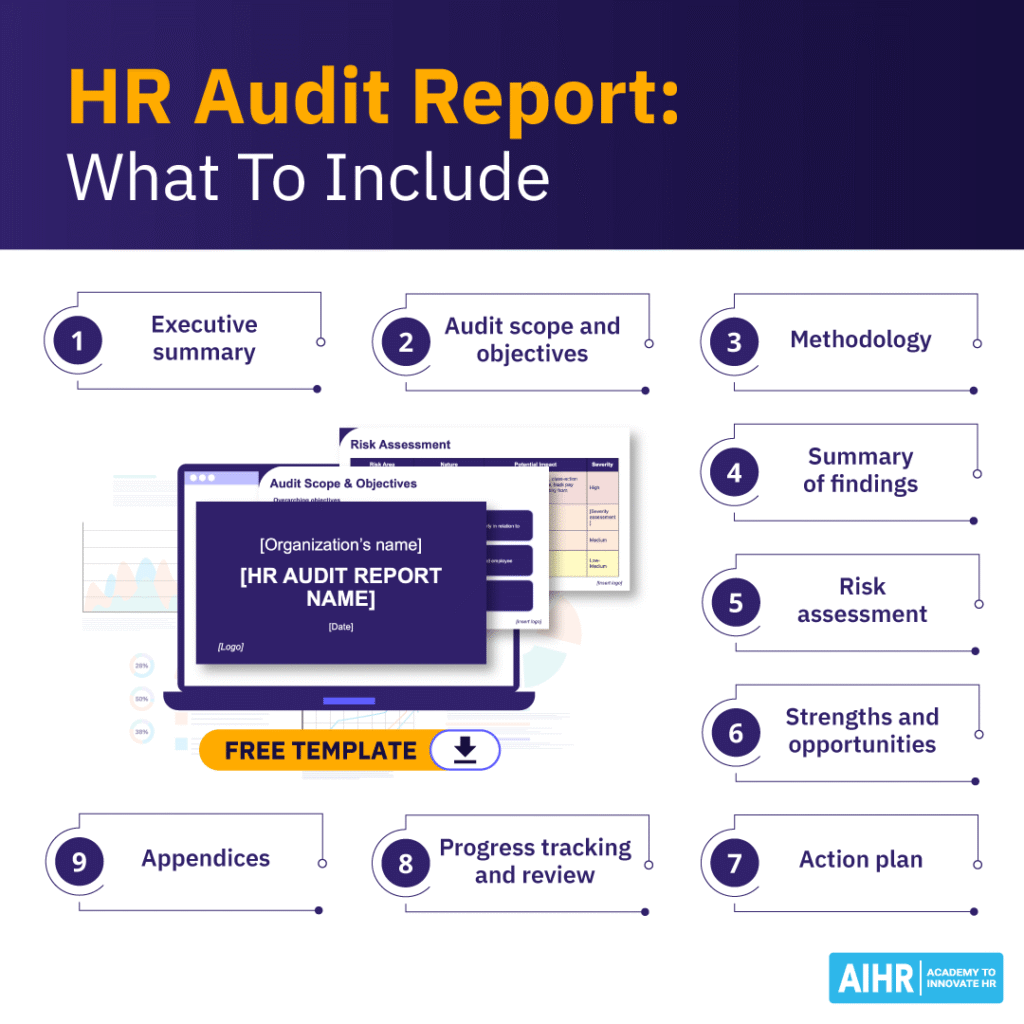
HR audit report format
The way you communicate your findings is just as important as the findings themselves, so use these tips to enhance readability and impact:
- Choose the right medium:
- Slides: PowerPoint, Google Slides, Keynote, or other presentation tools are ideal for live meetings, enabling a structured narrative and high-level overview with interactive discussion. Download a free, customizable HR audit report PowerPoint template below.
- PDF or Word documents: Best for detailed reports, allowing for thorough review, documentation, and comprehensive explanations for broader distribution.
- Accompanying video: A brief video summary can be highly effective for quickly conveying main points and adding a personal touch. Videos don’t need to be high-budget – simple screen recordings with a voice-over created in tools like Loom can do the trick.
- Highlight key facts and findings: Use bold text, call-out boxes, or dedicated summary sections to draw immediate attention to important information. This ensures that your audience, particularly your busy senior stakeholders, can quickly grasp high-impact risks or key recommendations.
- Use visuals strategically: Consider simple visuals, such as traffic light indicators, dashboards, color-coding, or tables, to display status at a glance. And avoid overloading your report with complex graphics that distract from the core message and require extensive explanation.
- Maintain professionalism: Keep an eye on brand identity, professional fonts, and a clean, uncluttered layout so that nothing distracts from your message. A polished report reflects positively on HR’s attention to detail, making your findings more persuasive.
8 best practices for creating an HR audit report
Follow these pointers to make sure your findings and recommendations deliver impact:
- Write your report with your audience in mind: When communicating with different audiences, such as executives (executive committee or C-suite), HR colleagues, or other stakeholders, it’s important to tailor your language and level of detail to their needs.
Senior executives are often inundated with presentations and appreciate high-level summaries that highlight key risks, opportunities, and strategic implications, drilling down on business impact and ROI. So, focus on conciseness, actionable insights, and clear visuals to make your report stand out and resonate. On the other hand, your HR colleagues may need more detailed information on processes. - Keep it clear and structured: Use a consistent report format with clear headings, subheadings, numbering, bullet points, and ample white space for breathing room. This will make your report easy to scan and digest, so your message isn’t lost in dense text.
- Highlight what matters most: Position high-risk or high-impact findings early in the report, and always include these factors in your Executive Summary. This ensures that the most critical issues receive immediate attention and understanding.
- Support findings with evidence: Your conclusions and recommendations should always be backed by relevant data, documentation, policy references, or specific examples. This will increase the credibility of your report and make it easier to shore up support for your findings.
- Balance transparency and sensitivity: Be honest and objective about gaps and areas for improvement, but be careful in avoiding language that blames individuals or teams. Use neutral phrasing and focus on solutions to systemic issues instead. The goal should always be to improve, not to criticize.
- Maintain confidentiality and accuracy: As an HR leader, you know how important it is to be cautious when sharing sensitive employee and organizational information, especially if the report is to be widely distributed. Double-check all your facts, figures, quotes, and policy references for accuracy before finalizing the report, and anonymize data where possible.
- Focus on solutions, not just problems: While identifying issues is key, balance the focus in your report to also include actionable solutions and the positive impact these solutions will have. Frame your findings as opportunities for growth and improvement.
- Include a follow-up mechanism: No HR audit report is complete without a clear plan for reviewing progress on your action items. This should involve regular check-ins, follow-up audits, and a designated project manager to ensure accountability.
HR tip: Common mistakes to avoid in reporting
Sidestep these six pitfalls to make sure your HR audit report lands with impact:
- Overwhelming with data: Don’t just dump raw data; interpret it and highlight the most relevant insights.
- Overestimating shared understanding: Remember, your audience may not possess the same deep level of HR expertise as you, or familiarity with HR issues, so just don’t assume they understand acronyms, internal processes, or the nuances of HR regulations.
- Using jargon: Translate technical HR terms into plain business language for non-HR audiences.
- Lack of business context: Always connect your HR findings to their broader impact on organizational goals, productivity, or financial health.
- No clear call to action: Make sure your recommendations are specific, measurable, achievable, relevant and time-bound.
- Blaming, not solving: Focus on identifying and addressing the causes of systemic issues and solutions rather than assigning individual blame.
HR audit report example
The following example demonstrates what a comprehensive HR audit report might look like in practice. It showcases how findings, risks, and recommendations are typically presented and can be used as a reference for structuring your own HR audit documentation.
HR audit report template
Download and customize our pre-built HR audit report template to save time in building an impactful and professional PowerPoint presentation.
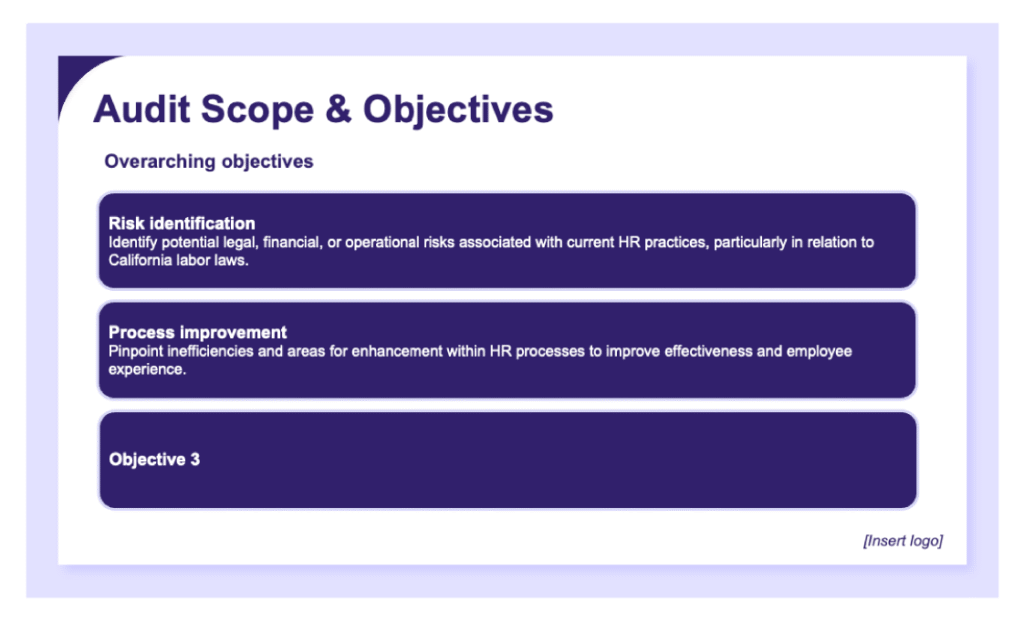
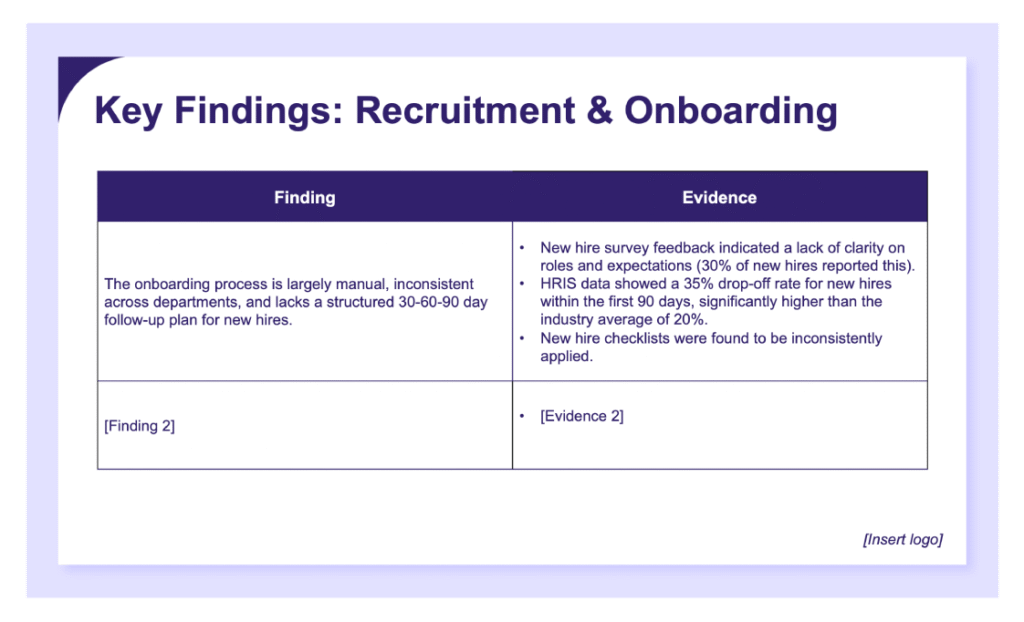
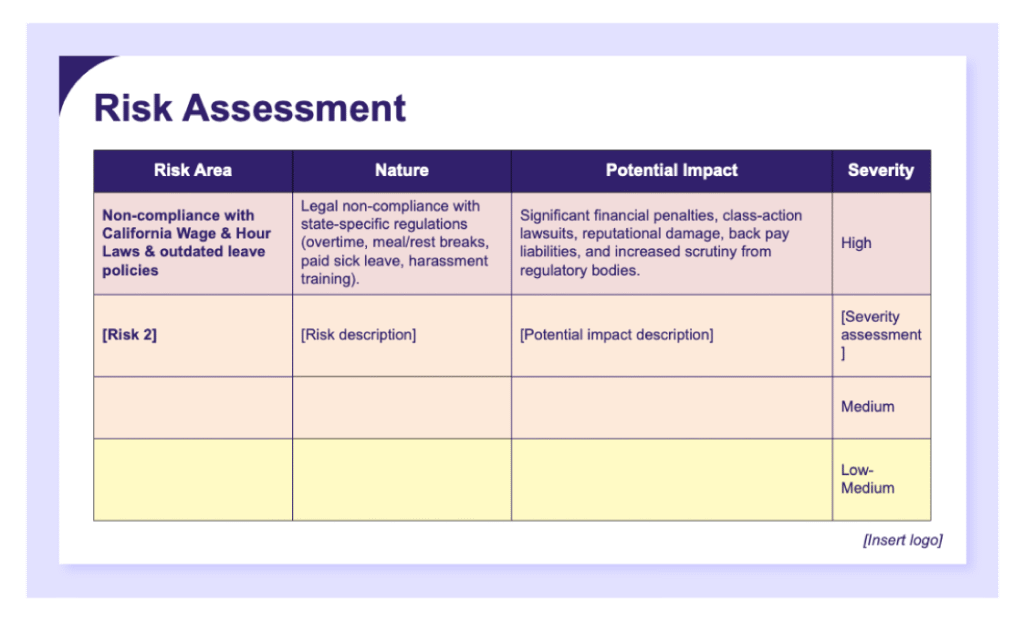
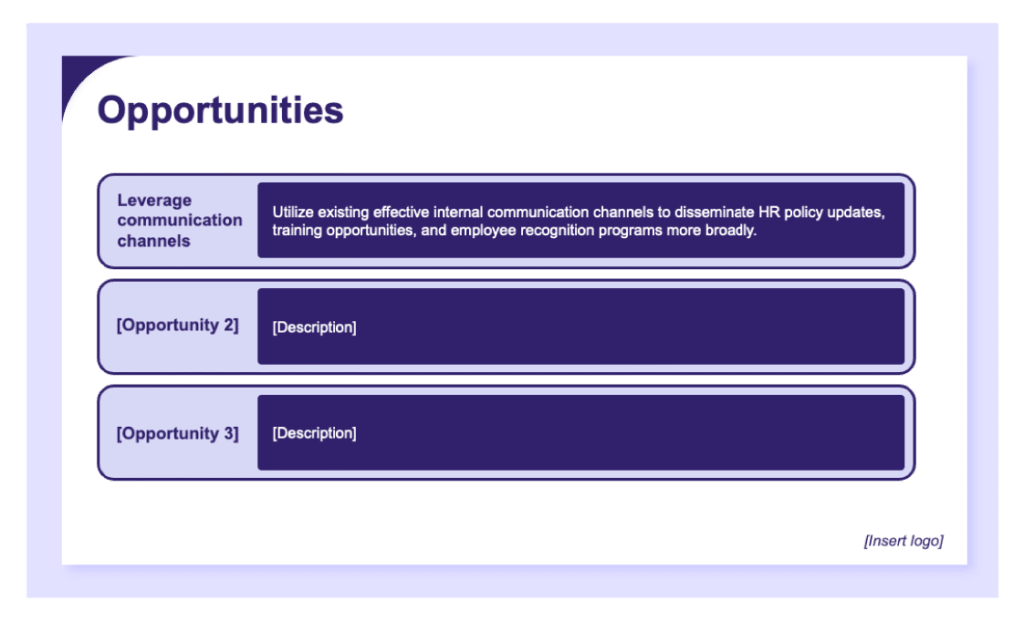
A final word
An HR audit report should go beyond simply reporting data and findings. Its true value is in highlighting strengths, identifying weaknesses, pinpointing gaps, and showcasing opportunities within your HR processes, data, and systems.
By following the structured approach outlined in this guide to document and communicate these insights, you can transform potential liabilities into catalysts for growth, enhance compliance, and solidify HR’s role as a partner and drive value across your organization.


